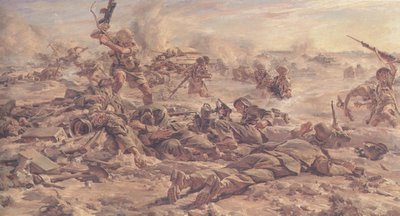
The best war illustrator you've never heard of is Ivor Hele (1912-1993) who depicted searing images of combat and military life in World War II and the Korean War.


As an official war artist for the Australian government, Hele spent a year at the frontlines in the North African campaign from 1941-42.


Hele then traveled to the South Pacific island of New Guinea where he drew and painted the fierce combat between the Australians and the Japanese in dark and difficult jungle terrain.



He returned to Australia physically and emotionally exhausted and began a prolific period in his career. After a year, he returned to New Guineau where he worked in the trenches with the troops until he was injured. Hele lay unconscious for two days. He was transported to a hospital in Australia where, after a long convalesence, he resumed working. At the height of the Korean War, Hele spent five months in the mud and the cold of Korea, brilliantly recording the struggles of the Australian soldiers in their trenches.




After the war, Hele illustrated a few books, magazines and calendars, but he was mostly kept busy with commissions to illustrate great battles of the second world war. Almost 500 of his paintings and drawings are housed at the Australian War Memorial.

The most striking thing about Ivor Hele was that, after traveling the globe and devoting his life to recording every form of savagery that humans can wreak upon each other, he finally reached his saturation level of death and despair and retreated to an isolated cottage on a remote Australian beach. There he lived the life of a hermit, drawing and painting intimate pictures of his wife.

Other artists have found their muse in a particular woman and shut themselves off from the rest of the world--Gaston Lachaise and Bonnard to name just two. But in my view, Hele was far more poetic and tragic. A scorched human being, he stumbled out of the embrace of thanatos (death) and sought refuge in the arms of eros. His private drawings of his wife from this period are both graphic and lovely. One imagines that these sensitive studies of the human form were the best possible therapy for regaining his humanity.
No comments:
Post a Comment